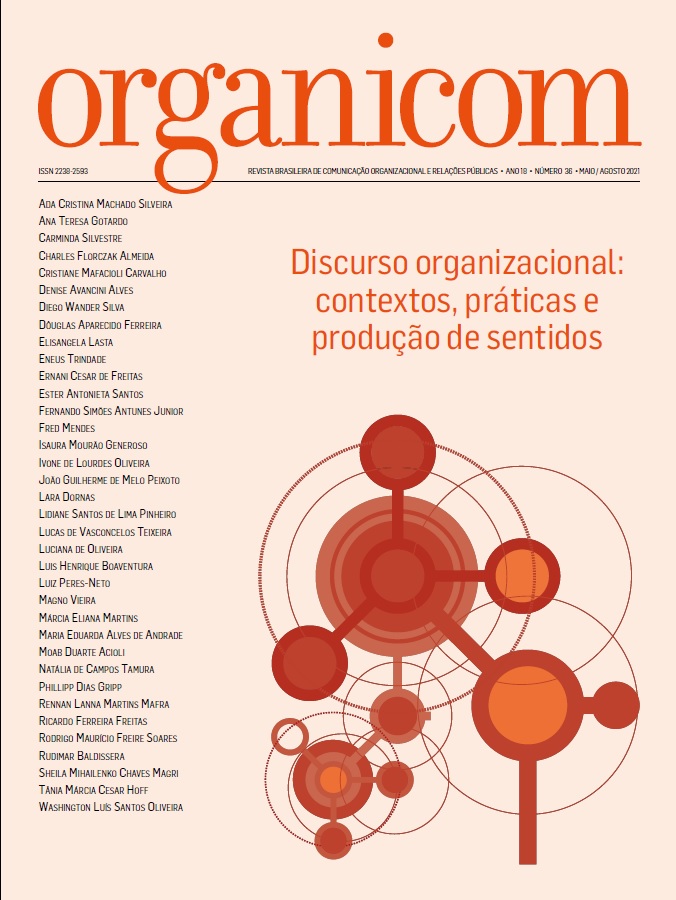Estrategias de comunicación a la reducción y orientación de la visibilidad en las redes sociales: prácticas discursivas y sociotécnicas
DOI:
https://doi.org/10.11606/issn.2238-2593.organicom.2021.185112Palabras clave:
Comunicación organizacional, Estrategias, Redes sociales, Reducción de la visibilidad, Orientación de la visibilidadResumen
Este artículo pretende reflexionar sobre las estrategias de reducción y orientación de la visibilidad en las redes sociales, destacando las conductas que cumplieron esta intención divulgadas en estudios científicos entre 2019 y 2021. Estas alternativas se caracterizan por un alto grado de profesionalización y por responder únicamente a intereses organizacionales. Para seleccionar los estudios adherentes, se utilizó la teoría fundamentada. Como resultado, destacamos el progreso de bots sociales y las incipientes investigaciones dedicadas a revelar los niveles de participación de las organizaciones.
Descargas
Referencias
ALTAMINI, Nawaf Abdelhay. Who controls the arab public sphere in the era of new media, the new revolutionists or the deep state? Journal of Content, Community & Communication, Madhya Pradesh, v. 12, ano 6, p. 312-323, 2020.
BALDISSERA, Rudimar. Comunicação e significação e significação na construção da imagem-conceito. Fronteiras, São Leopoldo, v. 10, n. 3, p. 193-200, 2008. DOI: https://doi.org/10.4013/5397.
BALDISSERA, Rudimar. Comunicação organizacional e gestão de marca: redes de organizações por articulação conceitual. In: ENCONTRO ANUAL DA ASSOCIAÇÃO NACIONAL DOS PROGRAMAS DE PÓS-GRADUAÇÃO EM COMUNICAÇÃO, 23., 2014, Belém. Anais […]. Belém: Compós, 2014. Disponível em: http://compos.org.br/encontro2014/anais. Acesso em: 28 abr. 2021.
BALDISSERA, Rudimar; VINHOLA, Bruno. Midiatização e comunicação organizacional: aproximações tentativas. Animus, Santa Maria, v. 19, n. 39, p. 22-39, 2020. DOI: https://doi.org/10.5902/2175497739595.
BULGACOV, Sergio; MARCHIORI, Marlene. Estratégia como prática: a construção de uma realidade social em processos de interação organizacional. In: MARCHIORI, Marlene (org.). Comunicação e organização: reflexões, processos e práticas. São Caetano do Sul: Difusão, 2010. p. 149-166.
COOPER, Tony; STAVROS, Constantino; DOBELE, Angela R. Domains of influence: exploring negative sentiment in social media. Journal of Product and Brand Management, v. 28, n. 5, p. 684-699, 2019.
EINWILLER, Sabine; STEILEN, Sarah. Handling complaints on social network sites – an analysis of complaints and complaint responses on Facebook and Twitter pages of large US companies. Public Relations Review, v. 41, n. 2, p. 195-204, 2015. DOI: https://doi.org/10.1016/j.pubrev.2014.11.012.
GIL, Antonio Carlos. Métodos e técnicas de pesquisa social. 7. ed. São Paulo: Atlas, 2021.
LASTA, Elisangela. Estratégias sociotécnicas de visibilidade e legitimidade na comunicação organizacional em rede. In: CONGRESSO BRASILEIRO DE CIÊNCIAS DA COMUNICAÇÃO, 40., 2017, Curitiba. Anais […]. Curitiba: Universidade Positivo, 2017. Disponível em https://professor.ufrgs.br/elisangela-lasta/files/r12-2846-1.pdf. Acesso em: 28 abr. 2021.
LITTLEJOHN, Stephen W. Fundamentos teóricos da comunicação humana. Rio de Janeiro: Zahar, 1982.
LIU, Xia. A big data approach to examining social bots on Twitter. Journal of Services Marketing, v. 33, n. 4, p. 369-379, 2019. DOI: https://doi.org/10.1108/JSM-02-2018-0049.
MENNIE, Phill. Social media risk and governance: managing enterprise risk. Philadelphia: Kogan Page, 2015.
ROSS, Björn et al. Are social bots a real threat? An agent-based model of the spiral of silence to analyse the impact of manipulative actors in social networks. European Journal of Information Systems, v. 28, n. 4, p. 394-412, 2019. DOI: https://doi.org/10.1080/0960085X.2018.1560920.
SILVA, Daniel Reis. Organizações privadas e lógicas indiretas de influência sobre a opinião pública: problemática e desafios para pesquisa. In: FARIAS, Luiz Alberto; LEMOS, Else; REBECHI, Cláudia Nociolini (org.). Opinião pública, comunicação e organizações: convergências e perspectivas contemporâneas. São Paulo: Abrapcorp, 2020. p. 32-50.
SILVA, Diego Wander da. Comunicação organizacional e as estratégias de invisibilidade e de redução/direcionamento da visibilidade nas mídias sociais. 2018. Tese (Doutorado em Comunicação e Informação) – Universidade Federal do Rio Grande do Sul, Porto Alegre, 2018.
SILVA, Diego Wander da; BALDISSERA, Rudimar. Comunicação organizacional e as estratégias de invisibilidade e de redução/direcionamento da visibilidade nas mídias sociais. Organicom, São Paulo, v. 16, n. 31, p. 16-26, 2019. DOI: https://doi.org/10.11606/issn.2238-2593.organicom.2019.163239.
TUTEN, Tracy; PEROTTI, Victor. Lies, brands and social media. Qualitative Marketing Research, v. 22, n. 1, p. 5-13, 2019. DOI: https://doi-org.ez94.periodicos.capes.gov.br/10.1108/QMR-02-2017-0063.
VAŠÍČKOVÁ, Veronica. Crisis management process: a literature review and a conceptual integration. Acta Oeconomica Pragensia, Praga, v. 27, p. 61-77, 2019. DOI: https://doi.org/10.18267/j.aop.628.
WOLFSWINKEL, Joost F.; FURTMUELLER, Elfi; WILDEROM, Celeste P. M. Using grounded theory as a method for rigorously reviewing literature. European Journal of Information Systems, Londres, v. 22, p. 45-55, 2013. DOI: https://doi.org/10.1057/ejis.2011.51.
Descargas
Publicado
Número
Sección
Licencia
Derechos de autor 2021 Diego Wander Silva

Esta obra está bajo una licencia internacional Creative Commons Atribución-NoComercial-CompartirIgual 4.0.
A submissão implica a cessão de direitos da primeira publicação à revista Organicom, sem pagamento. Os autores podem estabelecer por separado acordos adicionais para a distribuição não exclusiva de versão da obra publicada na revista (como colocar em um repositório institucional ou publicar um livro), com o devido reconhecimento de sua publicação inicial na revista Organicom.


